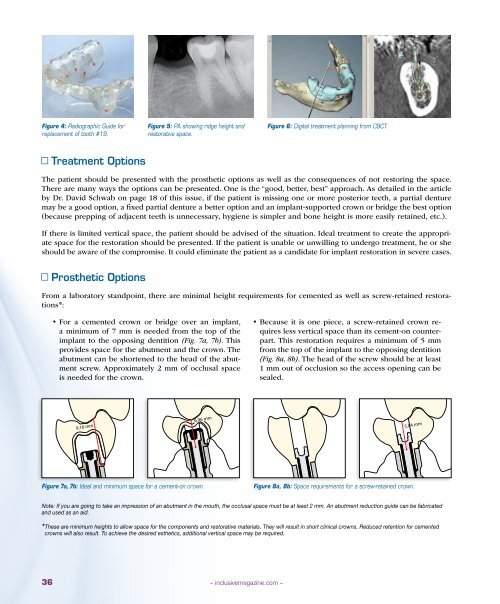PDF Download - Glidewell Dental Labs
PDF Download - Glidewell Dental Labs
PDF Download - Glidewell Dental Labs
Create successful ePaper yourself
Turn your PDF publications into a flip-book with our unique Google optimized e-Paper software.
Figure 4: Radiographic Guide for<br />
replacement of tooth #19.<br />
Figure 5: PA showing ridge height and<br />
restorative space.<br />
Figure 6: Digital treatment planning from CBCT.<br />
■ Treatment Options<br />
The patient should be presented with the prosthetic options as well as the consequences of not restoring the space.<br />
There are many ways the options can be presented. One is the “good, better, best” approach. As detailed in the article<br />
by Dr. David Schwab on page 18 of this issue, if the patient is missing one or more posterior teeth, a partial denture<br />
may be a good option, a fixed partial denture a better option and an implant-supported crown or bridge the best option<br />
(because prepping of adjacent teeth is unnecessary, hygiene is simpler and bone height is more easily retained, etc.).<br />
If there is limited vertical space, the patient should be advised of the situation. Ideal treatment to create the appropriate<br />
space for the restoration should be presented. If the patient is unable or unwilling to undergo treatment, he or she<br />
should be aware of the compromise. It could eliminate the patient as a candidate for implant restoration in severe cases.<br />
■ Prosthetic Options<br />
From a laboratory standpoint, there are minimal height requirements for cemented as well as screw-retained restorations*:<br />
• For a cemented crown or bridge over an implant,<br />
a minimum of 7 mm is needed from the top of the<br />
implant to the opposing dentition (Fig. 7a, 7b). This<br />
provides space for the abutment and the crown. The<br />
abutment can be shortened to the head of the abutment<br />
screw. Approximately 2 mm of occlusal space<br />
is needed for the crown.<br />
• Because it is one piece, a screw-retained crown requires<br />
less vertical space than its cement-on counterpart.<br />
This restoration requires a minimum of 5 mm<br />
from the top of the implant to the opposing dentition<br />
(Fig. 8a, 8b). The head of the screw should be at least<br />
1 mm out of occlusion so the access opening can be<br />
sealed.<br />
Figure 7a, 7b: Ideal and minimum space for a cement-on crown.<br />
Figure 8a, 8b: Space requirements for a screw-retained crown.<br />
Note: If you are going to take an impression of an abutment in the mouth, the occlusal space must be at least 2 mm. An abutment reduction guide can be fabricated<br />
and used as an aid.<br />
* These are minimum heights to allow space for the components and restorative materials. They will result in short clinical crowns. Reduced retention for cemented<br />
crowns will also result. To achieve the desired esthetics, additional vertical space may be required.<br />
36<br />
– inclusivemagazine.com –
















